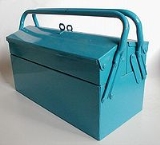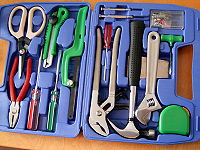
Toolbox
Encyclopedia


Do it yourself
Do it yourself is a term used to describe building, modifying, or repairing of something without the aid of experts or professionals...
.
Types of toolboxes
Modern toolboxes are predominantly metalMetal
A metal , is an element, compound, or alloy that is a good conductor of both electricity and heat. Metals are usually malleable and shiny, that is they reflect most of incident light...
or plastic
Plastic
A plastic material is any of a wide range of synthetic or semi-synthetic organic solids used in the manufacture of industrial products. Plastics are typically polymers of high molecular mass, and may contain other substances to improve performance and/or reduce production costs...
. Wood for the construction of toolboxes was the material of choice for boxes built beginning in the early 19th century. After several decades of decline in popularity, today a resurgence in use is underway. Viewed by many as intended primarily for specialized craftsmanship, such as machinist, tool and die makers, jewelers and other specialized craftsmen, they are also sought after by average tradesman and collectors as working heirloom
Heirloom
In popular usage, an heirloom is something, perhaps an antique or some kind of jewelry, that has been passed down for generations through family members....
. A modern carpenters' toolbox is composed of a base, a pivotally-mounted top cover, and usually a rack-mounted inside for convenient access. Many toolboxes, and chests from a variety of trades can be seen at the Smithsonian Museum of American History
National Museum of American History
The National Museum of American History: Kenneth E. Behring Center collects, preserves and displays the heritage of the United States in the areas of social, political, cultural, scientific and military history. Among the items on display are the original Star-Spangled Banner and Archie Bunker's...
.
Toolboxes commonly have a hinged cover for a top with a handle for carrying, and one or more latches securing the cover to the box.
Open smaller compartments are typically located inside, but larger toolboxes will often have a removable tote tray sitting on a flange
Flange
A flange is an external or internal ridge, or rim , for strength, as the flange of an iron beam such as an I-beam or a T-beam; or for attachment to another object, as the flange on the end of a pipe, steam cylinder, etc., or on the lens mount of a camera; or for a flange of a rail car or tram wheel...
inside the lip of the box, with a single larger compartment below.
Toolchests sometimes use slide out drawers or cantilever trays in lieu of the voluminous open space of the previously mentioned design.
It is less common for these tool storage containers to have a tote tray, although they typically have a hinged top chest storage compartment.
Tool chests are primarily made of metal
Metal
A metal , is an element, compound, or alloy that is a good conductor of both electricity and heat. Metals are usually malleable and shiny, that is they reflect most of incident light...
, though some expensive models are made of hardwoods.
Often they are sold as a set of a rolling bottom chest with a second, stepped in chest resting above. (Top Chest)
Although Tool Chests are designed typically with wheels they are not considered portable because of their massive weight and size.
Toolcarts (also known as Rollcabs) are commonly used in the transportation industry for maintenance and repair of vehicles on location.
Used as portable work stations, some of the larger types are self powered and propelled as example in automotive racing Pit Carts.
Material
Metal toolboxes (typically steelSteel
Steel is an alloy that consists mostly of iron and has a carbon content between 0.2% and 2.1% by weight, depending on the grade. Carbon is the most common alloying material for iron, but various other alloying elements are used, such as manganese, chromium, vanadium, and tungsten...
) weigh more than plastic ones. A plastic toolbox laden with tools can weigh the same that a comparable steel box does when empty. Metal boxes are also subject to rusting and their sharp edges can mark the surfaces of things they are banged against. Metal is, however, known for being stronger than plastic, so one should balance its disadvantages against the need to withstand abuse and support the weight of many tools.
Design
The simple box with tote tray can be effective, but becomes less so as more tools are added, due to the lack of storage and organizational capabilities. Some toolboxes even have compartments built into the lid for storing supplies such as nails and screws. Yet many tools still must be stored in the compartment below the tote. The large volume of space in this compartment makes this type of box easy to overfill, in terms of both weight and clutter. In addition to the trouble of finding things, there is a risk of heavier items damaging more delicate ones as the toolbox is moved around.A tote tray is a partitioned removable tray used to segregate small tools and items from other compartments.
Drawers
Drawers
Drawer or Drawers may refer to:* Drawer * A person who engages in drawing pictures* Payor, a person who draws a bill of exchange* Undergarment, underwear* Drawer test, a test used to detect rupture of the cruciate ligaments in the knee...
or cantilever trays minimize these problems. However, drawers increase the weight and thereby reduce the portability of the toolbox.
Alternatives to toolboxes
- Toolsets: These are molded plastic cases typically containing a variety of household or automotive tools. Each item snaps into a designated spot in the case, which makes organizing tools much easier than with a conventional toolbox. They are very compact, lightweight, and inexpensive relative to purchasing tools and a toolbox separately. There are two major disadvantages: no ability to customize the selection of tools (sometimes the tools are of lower quality than what one might purchase individually); and little or no space to add new tools and supplies. Thus one still might need a toolbox in addition to the toolset.
- Toolbelts and apronApronAn apron is an outer protective garment that covers primarily the front of the body. It may be worn for hygienic reasons as well as in order to protect clothes from wear and tear. The apron is commonly part of the uniform of several work categories, including waitresses, nurses, and domestic...
s: Though at the far extreme of portability, they are insufficient for storing a large number of tools. One might use a toolbox for permanent storage and a toolbelt or apron to take just what is needed for a job. They are used in locations where a worker needs access to more tools than he can carry with just his hands while working in a location with no place to set tools down, such as working on a ladder or hanging from a utility pole. These are also frequently worn by award winning actor Evan Stone (AKA Toolbelt man). - Bucket organizers: These consist of rugged fabricTextileA textile or cloth is a flexible woven material consisting of a network of natural or artificial fibres often referred to as thread or yarn. Yarn is produced by spinning raw fibres of wool, flax, cotton, or other material to produce long strands...
or polyesterPolyesterPolyester is a category of polymers which contain the ester functional group in their main chain. Although there are many polyesters, the term "polyester" as a specific material most commonly refers to polyethylene terephthalate...
bags draped into and around a 5 gallon bucket. They are lightweight, inexpensive, and can rival the toolbox as a means of storing and moving tools to a job site. Their dozens of pockets permit better organization, yet nearly everything is visible at first glance. That, however, could be a disadvantage as well, since one may have privacy or security concerns if the bucket has to (they may also have handles.) be left in a public area. (By contrast, toolboxes are often lockable and, obviously, opaque). In a vehicle, the bucket may be jostled into spilling some of its contents. Tools left outdoors are better protected in a toolbox. For many purposes, however, a bucket organizer may be preferable to a toolbox. Before purchasing a bucket organizer, note that the bucket itself usually is not included. - "Autocarts": These are utility carts having a pivoting base for storage in vehicles. They are used by tradespersons to carry tools, equipment or supplies. They combine advantages of toolboxes and toolbelts and are essentially portable truckboxes or transportable shopping carts.
Toolboxes in computing
The term toolbox is used in computing to represent a set of subroutineSubroutine
In computer science, a subroutine is a portion of code within a larger program that performs a specific task and is relatively independent of the remaining code....
s (or functions) and global variable
Global variable
In computer programming, a global variable is a variable that is accessible in every scope . Interaction mechanisms with global variables are called global environment mechanisms...
s. Typically these implement missing functionality using capabilities available in the core software.

